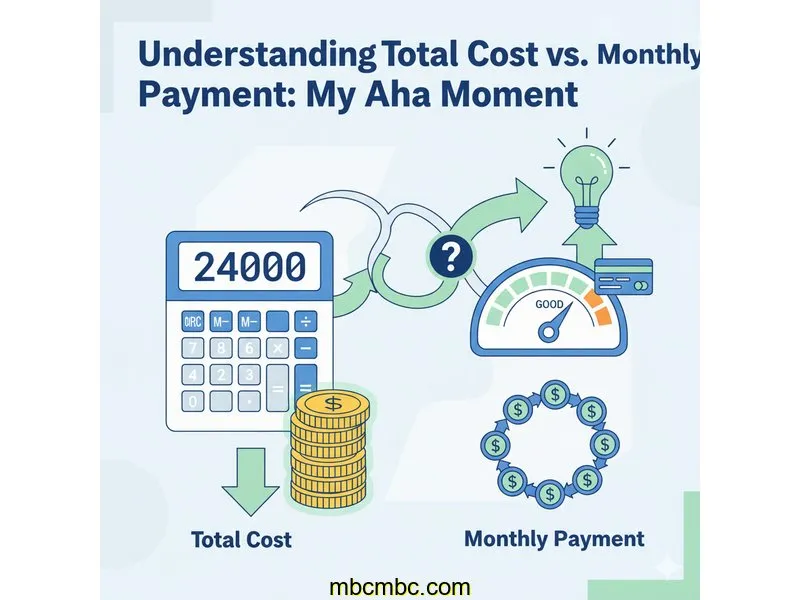
Auto Loan Calculator
Calculate payments over the life of your Loan
Home Blog Privacy Terms About Contact
Calculate payments over the life of your Loan
Home Blog Privacy Terms About ContactPublished on October 14, 2025

My journey into the world of loan math started with a simple conversation. A friend was proudly telling me about a personal loan they got for a new home office setup. They were thrilled about their monthly payment, which sounded incredibly low. My first thought was, "Wow, that's a great deal!" But then they mentioned the loan term: six years. Six years felt like a long time, and a little question popped into my head: how much does that loan actually cost in the end?
I wasn't trying to judge their decision at all. I was genuinely curious about the mechanics behind it. How could the payment be so low for a decent-sized loan? What was the trade-off? This wasn't about finding a "better" loan; it was about understanding the numbers and the relationship between them. I wanted to see the math for myself, to connect the dots between the monthly payment, the loan term, and the total amount of money paid over time.
So, I opened up an online loan calculator, not to shop for anything, but just to play with the numbers. My goal was simple: to figure out why my friend's low monthly payment felt both appealing and slightly puzzling at the same time. What was I missing? How did changing one number, the loan term, cause all the other numbers to shift so dramatically? This exploration is just me sharing what I learned about how these calculations work. It's about my journey to understand the math, not about giving any kind of financial advice.
My first experiment was to create a hypothetical scenario. I imagined a loan for a similar purpose, let's say $13,800. I found a representative interest rate online, something like 6.8%, just to have a number to work with. My friend had a six-year term, which is 72 months, so I started there. I plugged these values into the calculator: $13,800 for the loan amount, 6.8% for the annual interest rate, and 72 months for the term.
The result came back: a monthly payment of about $233.15. I understood immediately why my friend was so pleased. That number, on its own, seems very manageable. It’s easy to look at that figure and think, "I can definitely fit that into my budget." And for a while, that's where my focus stayed. I was fixated on that single, attractive number.
Then, my initial curiosity kicked back in. What if the term was shorter? I changed the term to 36 months (three years) and left all the other numbers the same. The calculator instantly updated. The new monthly payment was $424.31. My immediate reaction was a slight wince. That’s nearly double the other payment! My brain automatically categorized the first scenario as "good" and the second one as "bad" based on that monthly payment alone. I was comparing apples and oranges without even realizing it.
But I felt like I was still missing a crucial piece of the puzzle. I had two monthly payments, but I didn't have the full picture. I knew, logically, that paying for six years versus three years had to mean something more, but I couldn't see it yet. I stared at the calculator results, looking at the other output fields it provided: "Total Principal Paid," "Total Interest Paid," and "Total Cost of Loan." That’s when I realized my mistake. I was only looking at one number when the calculator was trying to tell me a much bigger, more interesting story.

The breakthrough moment was subtle but powerful. It wasn't a complex formula that suddenly clicked; it was simply me shifting my eyes from one box on the calculator to another. I decided to ignore the monthly payment for a second and focus on the field labeled "Total Interest Paid." This was the key that unlocked the entire concept for me.
In the 72-month (6-year) scenario, with its inviting $233.15 monthly payment, the total interest paid was $2,986.80. I let that number sink in. That was the cost of borrowing the money over six years. Then, I toggled the term back to 36 months. The monthly payment jumped back up to $424.31, but the total interest paid dropped to just $1,475.16. Seeing those two interest figures side-by-side was my real "aha" moment. The longer loan, despite its comfortable monthly payment, cost more than double in interest.
I had been so focused on the short-term cash flow (the monthly payment) that I had completely missed the long-term cost (the total interest). To make it crystal clear for myself, I built a simple table to compare the two scenarios directly. This visual aid made the trade-off undeniable.
My first step in solidifying this understanding was to manually verify the "Total Payments" number. It seemed simple, but doing it myself made it stick. For the 3-year loan, I multiplied the monthly payment by the term: $424.31 x 36 months = $15,275.16. I did the same for the 6-year loan: $233.15 x 72 months = $16,786.80. The numbers matched the calculator exactly. This basic multiplication confirmed where the total cost figure came from.
The next connection was just as simple but even more enlightening. The total interest is simply the total amount you pay minus the original loan amount. For the 3-year loan: $15,275.16 (Total Paid) - $13,800 (Loan Amount) = $1,475.16 (Total Interest). And for the 6-year loan: $16,786.80 - $13,800 = $2,986.80. This simple subtraction revealed the true cost of borrowing the money in each scenario.
To make sure this wasn't a fluke, I ran a completely different scenario. I imagined a loan of $19,250 at a 7.2% interest rate. I compared a 48-month term to a 60-month term. Sure enough, the same pattern emerged. The 48-month loan had a higher monthly payment (around $466) but less total interest (around $3,118). The 60-month loan had a lower monthly payment (around $385) but more total interest (around $3,850). This confirmed my understanding: a longer loan term spreads the principal payments out, meaning interest accrues for a longer period on a higher remaining balance, leading to a higher total interest cost.
This whole exercise was incredibly empowering. I went from being puzzled by a low monthly payment to understanding the mechanics behind it. My perspective on loan calculators changed completely; they became learning tools rather than just answer machines. Here are the key lessons I took away about the calculations themselves:
This was one of the first things I learned to do myself to verify a calculator's results. The calculation is straightforward: multiply your exact monthly payment by the total number of months in your loan term. For example, a $350 monthly payment for 48 months means you will pay a total of $350 x 48 = $16,800.
Once you know the total amount you'll pay (from the calculation above), you just subtract the original loan amount. If you borrowed $14,000 and your total payments are $16,800, the total interest cost is $16,800 - $14,000 = $2,800. This number represents the true cost of borrowing the principal.
I learned this is because interest is calculated on the outstanding balance. With a longer term, your monthly payments are smaller, which means you are paying down the principal balance more slowly. Since the balance stays higher for longer, more interest accumulates over the life of the loan, even if the interest rate is the same.
From my experience, I've found that reputable online calculators are excellent tools for understanding how the math works and for getting estimates. They use the same standard amortization formulas. However, the key is to remember they are educational tools. A final loan offer from a lender will have the official figures, which will be precise down to the penny.
My journey started with a simple question about a friend's low monthly payment, and it ended with a much deeper appreciation for the story numbers can tell. The single biggest lesson for me was learning to look beyond the most obvious figure—the monthly payment—and seek out the "Total Interest Paid." That one field on the calculator provided the context I was missing and transformed my understanding.
It showed me that borrowing money involves a trade-off between short-term affordability and long-term cost. There isn't a universally "right" answer, but understanding the math behind both sides of that trade-off feels incredibly valuable. It's empowering to know how to use these tools not just to get an answer, but to understand *why* the answer is what it is.
I'd encourage anyone curious about these topics to do the same: open a calculator, plug in some hypothetical numbers, and just play. Change one variable at a time and watch how the others react. It's a fantastic way to build confidence and literacy around financial math, one calculation at a time.
This article is about understanding calculations and using tools. For financial decisions, always consult a qualified financial professional.
Disclaimer: This article documents my personal journey learning about loan calculations and how to use financial calculators. This is educational content about understanding math and using tools—not financial advice. Actual loan terms, rates, and costs vary based on individual circumstances, creditworthiness, and lender policies. Calculator results are estimates for educational purposes. Always verify calculations with your lender and consult a qualified financial advisor before making any financial decisions.
